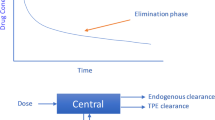Abstract
It has been recently suggested that an acquired deficiency of proteins C and S could contribute to the pathogenesis of meningococcemic purpura fulminans (PF) in children. Our study was designed to measure the levels of antithrombin III (AT III), protein C, and protein S during adult PF and to determine the effects of an early infusion of high doses of AT III concentrates on clinical and biological alterations of PF. We studied five consecutive adult patients with meningococcemia (type B) and PF. The levels of AT III, protein C (antigen and activity), and protein S (total and free) were measured at admission and 24 h and 1 month later. The treatment included in each case: amoxycillin, dobutamine and high doses of AT III concentrates. All patients survived and were discharged without any sequelae. At admission, biological data were consistent with severely depressed protein C and protein S levels and moderately decreased AT III levels, without any discrepancy between protein C antigen and activity. After 24 h, AT III and protein S levels were within normal ranges, whereas protein C levels were still depressed. These data are consistent with the theory of a particular imbalance in the anticoagulant systems during meningococcemic PF, contrasting with the usual findings observed during septic disseminated intravascular coagulation. The possibility must be considered that high doses of one anticoagulant (AT III concentrates) could compensate for the acute decrease in the other (protein C system).
Similar content being viewed by others
References
Powars DR, Rogers ZR, Patch MJ, McGehee WG, Francis RB (1987) Purpura fulminans in meningococcemia: association with acquired deficiencies of proteins C and S. N Engl J Med 317:571–572
Bick RL (1982) Clinical relevance of antithrombin III. Semin Thromb Hemost 8:276–287
Stenbjerg S, Pedersen EG, Laursen H (1983) Coagulation fibrinolytic and antithrombin III profiles in severely infected patients. Thromb Res 31:635–640
Emerson TE, Fournel MA, Leach WJ, Redens TB (1987) Protection against disseminated intravascular coagulation and death by antithrombin III in theE. coli endotoxemic rate. Circ Shock 21:1–13
Hauptmann JG, Hassouna HI, Bell TG, Penner JA, Emerson TE (1988) Efficacy of antithrombin III in endotoxin induced disseminated intravascular coagulation. Circ Shock 25:111–122
Blauhut B, Kramar H, Vinazzer H, Bergmann H (1985) Substitution of antithrombin III in shock and disseminated intravascular coagulation. Thromb Res 39:81–89
Odegard OR, Lie M, Abildgaard U (1975) Heparin cofactor activity measured with an amydolytic method. Thromb Res 6:287–294
Nicham F, Ghichaoua JF, Contant G, Martinoli JL (1988) Dosage rapide de l'activité de la protéine C. Ann Biol Clin (Paris) 46:805–808
Laurell OB (1966) Quantitative estimation of protein by electrophoresis in agarose gel containing antibodies. Ann Biochem 15:45–52
Comp PC, Doray D, Patton D, Esmon CT (1986) An abnormal plasma distribution of protein S occurs in functional protein S deficiency. Blood 67:504–608
Clauss A (1957) Gerinnungsphysiologische Schnellmethode zur Bestimmung des Fibrinogens. Acta Heamatol 17:237–247
Largo R, Heller V, Straub PW (1976) Detection of soluble intermediates of the fibrinogen-fibrin conversion using erythrocytes coated with fibrin monomers. Blood 47:991–10002
Griffin GH, Moscher DF, Zimmermann TS, Kleis AJ (1982) Protein C: an antithrombotic protein is reduced in hospitalized patients with intravascular coagulation. Blood 60:261–264
Mannucci PM, Vigano S (1982) Deficiency of protein C, an inhibitor of blood coagulation. Lancet II:463–467
Clouse LH, Comp PC (1986) The regulation of homeostasis. The protein C system. N Engl J Med 314:1298–1304
Marlar RA, Endres-Brooks J, Miller C (1985) Serial studies of protein C and its plasma inhibitor in patients with disseminated intravascular coagulation. Blood 66:59–63
Vandermeer FJ, Broekmans AW, Bertina RM, Briet B (1985) Protein C activity and antigen levels in patients with intravascular coagulation. Scand J Clin Lab Invest 45:133
Fourrier F, Lestavel P, Leclerc L, Chopin C, Marey A, Goudemand J (1987) Traitement des coagulations intravasculaires disséminées septiques par l'antithrombine III. Reanim Soins Intens Med Urgence 3:281 (abstr)
Author information
Authors and Affiliations
Rights and permissions
About this article
Cite this article
Fourrier, F., Lestavel, P., Chopin, C. et al. Meningococcemia and purpura fulminans in adults: acute deficiencies of proteins C and S and early treatment with antithrombin III concentrates. Intensive Care Med 16, 121–124 (1990). https://doi.org/10.1007/BF02575306
Received:
Accepted:
Issue Date:
DOI: https://doi.org/10.1007/BF02575306




